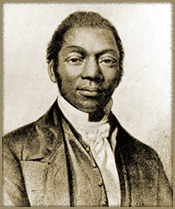







 |
 |
 |
 |
 |
| |
If it was such a secret, how do we know about it today?
Although we don't know where all the stations were and who all the conductors were, we do know a lot about the Underground Railroad. One way we know is from old documents. These treasures have survived for over a century. Many people left written records about the Underground Railroad.
Frederick Douglass wrote several books about his life. In them he describes his escape by train from Baltimore and also his work in Rochester, New York, where he often hid other people who were escaping to Canada. In Rochester, Douglass was the editor and publisher of an important anti-slavery newspaper called the North Star. The books Douglass wrote about his life are called: Narrative of the Life of Frederick Douglass (1845), My Bondage and My Freedom (1855), and Life and Times of Frederick Douglass (1884).
Another Maryland enslaved person who escaped, William Green, wrote the story of his life in 1853. This is entitled, Narrative of Events in the Life of William Green (Formerly a Slave.) This text can be found at the Library of Congress web site, "The Capital and the Bay: Narratives of Washington and the Chesapeake Bay Region, ca. 1600-1925." The man, who was born in Oxford Neck on the Eastern Shore, escaped with several companions. They traveled on foot for about two days. Finally they reached the home of a Quaker man who gave them a meal and directions. They walked for several more days until they reached the home of "Aunt Sarah" whose husband put them on the boat to Philadelphia. From Philadelphia, Green traveled by boat to New York, then on to Hartford, Connecticut, and finally to Springfield, Massachusetts where he settled.

James W.C. Pennington wrote about his life as an enslaved person and his decision to escape North to freedom in a book called The Fugitive Blacksmith.
|
Another famous Marylander who escaped slavery, J. W. C. Pennington, wrote about his life in a book called The Fugitive Blacksmith. This was published in London in 1849. You can find a modern reprint of this to read.
Some Underground Railroad conductors kept diaries that we can read today. One of the most extensive was kept by William Still a free black man who lived in Philadelphia. His house was the hub of Underground Railroad activities in the east. William Still kept records of all the fugitives who arrived at his place in Philadelphia. Many of them came from Maryland. This book, which came out in 1872, contains vivid accounts of escapes and of the operations of the Underground Railroad. It is called The Underground Rail Road.
Many other former fugitives and people who worked with the Underground Railroad also wrote accounts of their lives. Historians have done research and have written about the Underground Railroad. Historians can reconstruct the past by being good detectives. They collect all the evidence about what happened, put it together, and write it down so we all can know what happened long ago. You can read lots of histories of the Underground Railroad.
We can also find lots of newspaper accounts of enslaved people escaping. Owners often advertised for enslaved people who had run away, usually offering a generous reward to anyone who could capture and return them. The advertisements describe the physical appearance and often guess where he or she may be going. Newspapers often carried accounts of enslaved people that ran away and also of those that were recaptured. You can read many old newspapers at the library or on the internet.
We can look back at old court records. We can read about people being tried for helping enslaved people escape. Many old court records are kept at the Maryland Archives in Annapolis. So, you see, there are lots of ways to find out about the Underground Railroad.
Can I ride on the Underground Railroad today?
« back to About home
|
|
 |
 |
 |
|
 |
|










